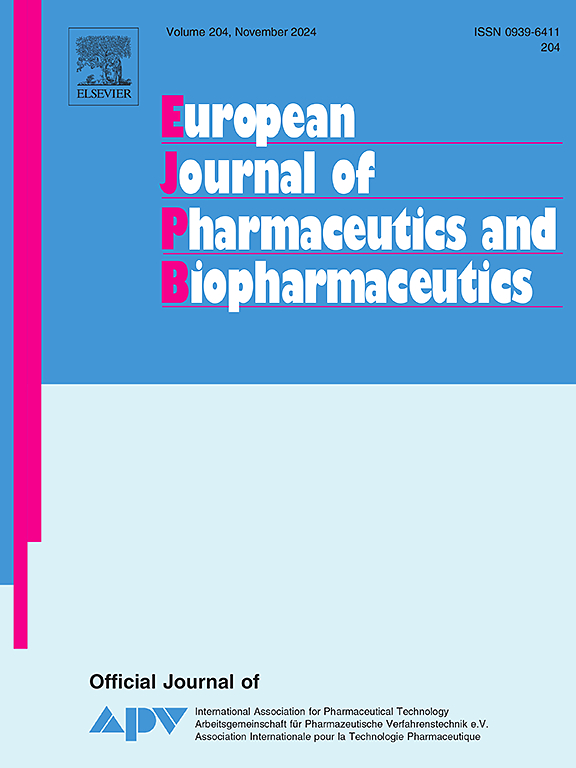Enhanced photodynamic therapy of curcumin using biodegradable PLGA coated mesoporous silica nanoparticles
IF 4.4
2区 医学
Q1 PHARMACOLOGY & PHARMACY
European Journal of Pharmaceutics and Biopharmaceutics
Pub Date : 2024-09-18
DOI:10.1016/j.ejpb.2024.114503
引用次数: 0
Abstract
Since the available treatments are not highly effective to combat cancer, therefore, the alternative strategies are unavoidable. Photodynamic therapy (PDT) is one of the emerging approaches which is target specific and minimally invasive. This study explores the successful development of Poly (D,L-lactide-co-glycolide) (PLGA) coated mesoporous silica nanoparticles (MSNs) and their augmented effects achieved by integrating curcumin (Cur) and cetyltrimethylammonium bromide (CTAB) in the polymeric layer and silica’s pores, respectively. The synthesized nanocarriers (Cur-PLGA-cMSNs) have shown preferential targeting to the cellular organelles facilitated by CTAB’s and Cur’s affinity to mitochondria. CTAB and Cur-based PDT induced oxidative stress and generation of reactive oxygen species (ROS), resulting in dysfunctional mitochondria and triggered apoptotic pathways. PLGA coating has produced multifunctional effects, including; gatekeeping effects at pore openings, providing an extra loading site, enhancing the hemocompatibility of MSNs, and masking the free cur-related prolonged coagulation time. Cur-PLGA-cMSNs, as a multifaceted and combative approach with synergistic effects demonstrate promising potential to enhance outcomes in cancer treatment.

利用可生物降解的聚乳酸(PLGA)包覆介孔二氧化硅纳米粒子增强姜黄素的光动力疗法。
由于现有的治疗方法在抗癌方面效果不佳,因此,替代策略是不可避免的。光动力疗法(PDT)是一种新兴的方法,它具有靶向特异性和微创性。本研究探讨了聚(D,L-乳酸-聚乙二醇)(PLGA)包覆介孔二氧化硅纳米颗粒(MSNs)的成功开发,以及通过在聚合物层和二氧化硅孔中分别加入姜黄素(Cur)和十六烷基三甲基溴化铵(CTAB)来增强其效果。合成的纳米载体(Cur-PLGA-cMSNs)通过 CTAB 和 Cur 对线粒体的亲和力,显示出对细胞器的优先靶向性。基于 CTAB 和 Cur 的光透射诱导氧化应激并产生活性氧 (ROS),导致线粒体功能失调并引发细胞凋亡。PLGA 涂层具有多功能效应,包括在孔开口处的把关效应、提供额外的装载位点、增强 MSN 的血液相容性以及掩盖与游离凝胶相关的凝血时间延长。Cur-PLGA-cMSNs 作为一种具有协同效应的多方面对抗方法,在提高癌症治疗效果方面展现出了巨大的潜力。
本文章由计算机程序翻译,如有差异,请以英文原文为准。
求助全文
约1分钟内获得全文
求助全文
来源期刊
CiteScore
8.80
自引率
4.10%
发文量
211
审稿时长
36 days
期刊介绍:
The European Journal of Pharmaceutics and Biopharmaceutics provides a medium for the publication of novel, innovative and hypothesis-driven research from the areas of Pharmaceutics and Biopharmaceutics.
Topics covered include for example:
Design and development of drug delivery systems for pharmaceuticals and biopharmaceuticals (small molecules, proteins, nucleic acids)
Aspects of manufacturing process design
Biomedical aspects of drug product design
Strategies and formulations for controlled drug transport across biological barriers
Physicochemical aspects of drug product development
Novel excipients for drug product design
Drug delivery and controlled release systems for systemic and local applications
Nanomaterials for therapeutic and diagnostic purposes
Advanced therapy medicinal products
Medical devices supporting a distinct pharmacological effect.

 求助内容:
求助内容: 应助结果提醒方式:
应助结果提醒方式:


